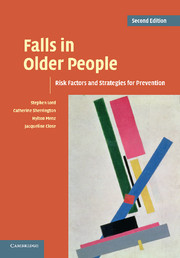Book contents
- Frontmatter
- Contents
- Preface
- Acknowledgements
- Part I Epidemiology and risk factors for falls
- Part II Strategies for prevention
- 10 Exercise interventions to prevent falls
- 11 Exercise interventions to improve physical functioning
- 12 Medical management of older people at risk of falls
- 13 Assistive devices and falls prevention
- 14 Modifying the environment to prevent falls
- 15 Prevention of falls in hospitals and residential aged care facilities
- 16 A physiological profile approach to falls risk assessment and prevention
- 17 Research into practice
- Part III Research issues in falls prevention
- Index
- References
11 - Exercise interventions to improve physical functioning
Published online by Cambridge University Press: 03 May 2010
- Frontmatter
- Contents
- Preface
- Acknowledgements
- Part I Epidemiology and risk factors for falls
- Part II Strategies for prevention
- 10 Exercise interventions to prevent falls
- 11 Exercise interventions to improve physical functioning
- 12 Medical management of older people at risk of falls
- 13 Assistive devices and falls prevention
- 14 Modifying the environment to prevent falls
- 15 Prevention of falls in hospitals and residential aged care facilities
- 16 A physiological profile approach to falls risk assessment and prevention
- 17 Research into practice
- Part III Research issues in falls prevention
- Index
- References
Summary
As indicated in Chapter 10, exercise is a key intervention strategy for preventing falls in older people. Many diverse forms of exercise have been used in trials, ranging from highly prescribed resistance training regimes and laboratory-based balance training to unstructured general exercise programmes. In addition to studying the efficacy of exercise programmes on falls, many studies have also assessed the effectiveness of such programmes on a range of physical outcome measures, including strength, balance and gait. These studies elucidate the mechanisms by which exercise may prevent falls. Although falls are relatively common, most older individuals do not fall very frequently. Thus, large studies with long follow-up periods are required to detect the effects of exercise on fall rates. In contrast, the effects of exercise on risk factors for falls can be detected with smaller studies. Thus, complementary information can be gleaned from the analysis of studies with falls risk factors as outcome measures. Indeed, Liu-Ambrose and colleagues found that the risk of falling, as measured on the Physiological Profile Assessment tool (PPA, described in Chapter 16), could be reduced by around 50% by resistance or agility training.
This chapter describes the major forms of exercise that have been used in studies of older people, and summarizes the evidence for the effectiveness of each form on falls risk factors such as balance, strength and functional abilities. Additional considerations, including exercise setting selection, target population selection, and factors affecting adoption and adherence, are then explored.
- Type
- Chapter
- Information
- Falls in Older PeopleRisk Factors and Strategies for Prevention, pp. 204 - 239Publisher: Cambridge University PressPrint publication year: 2007



